Tomato is a juicy delicate fruit that grows during summer and loves the warm weather. However, these same qualities are the reason why tomato plants are a magnet for pests. Insects thrive in warm weather and they tend to increase during the growing season of your tomato plants.
If the infestation in your garden is out of control, insecticides can be the best solution for you.
However, insecticides are not a one-size-fits-all solution. Not all insects can be killed by one type of insecticide since some insects have a next-level immunity to certain insecticides.
In this article, we’ll help you find the best insect spray or insecticide for your tomato plants. We’ll also share with you some tips in applying insecticides so you won’t kill the good insects or the pollinating ones.
(You could use the table of contents below to jump to the sections that are most important to you.)
First, let’s identify the pests in your garden so you’ll know what type of insecticide to look for.
Common Insect Infestation In Tomatoes
Before we proceed to the best insecticides for tomatoes in the market you must first identify the insect that’s killing your tomato plants.
Here are some of the notorious tomato plant insects that serve as a threat to your bountiful tomato harvest:
1. Aphids (Greenfly/Blackfly)

Aphids are small sap-sucking insects that multiply fast and attacks tomatoes in their early stage of growth.
These small but terrible insects weaken the plant by sucking the sap and are also notorious for spreading plant viruses that cause severe damage to tomatoes.
2. Whiteflies
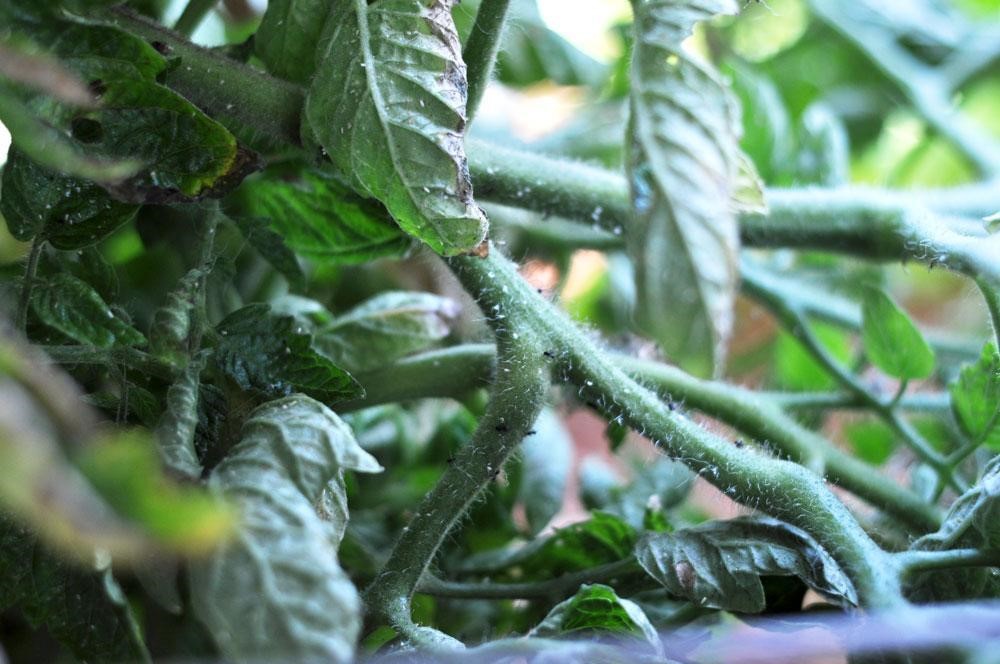
Whitefly is a type of insect that mostly found on the underside of tomato leaves. They also suck on the sap of the tomato plants and main distributors of plant viruses like the Tomato Yellow Leaf Curl Virus(TYLCV).
These insects can also affect the mechanical process in a plant’s system and affect its ripening process. When whiteflies start to feed on tomato plants, some tomatoes experience a ripening disorder due to the imbalance in honeydew supply in the plant.
3. Leafminers
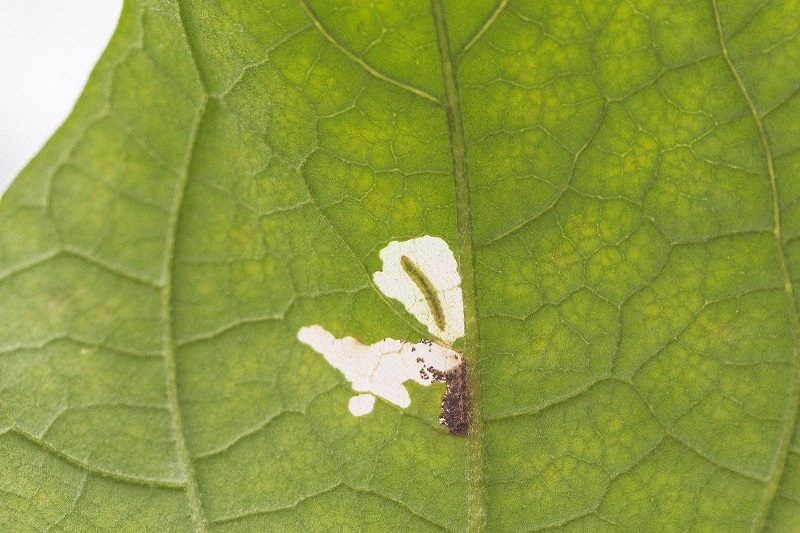
Leafminer is another type of pest in tomatoes that feeds on the leaf tissue of plants. You will easily identify this pest based on their feed patterns on the leaf. Beetles and moths are also called leaf-mining insects because they share the same feeding patterns as other leaf miners.
4. Tomato Hornworms
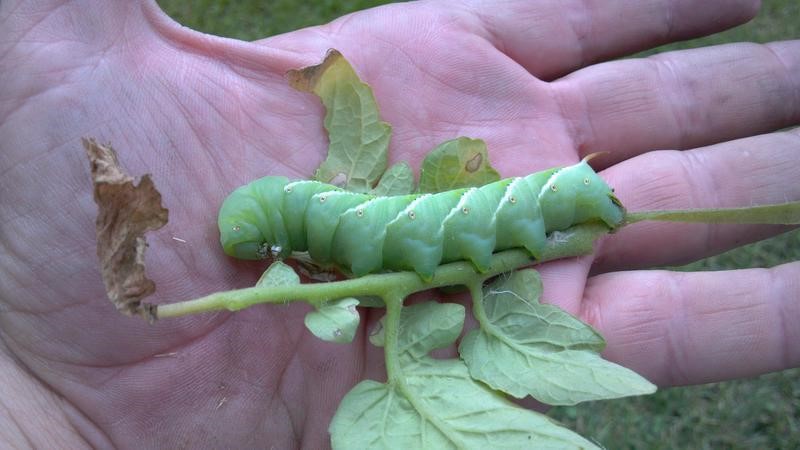
Tomato hornworms are one of the largest caterpillars that can feed on your tomato plant. Due to its size, it is known as a notorious leaf eater. Due to the leaf damages, fruit production is affected and sometimes they even feed on the fruits.
5. Cutworms
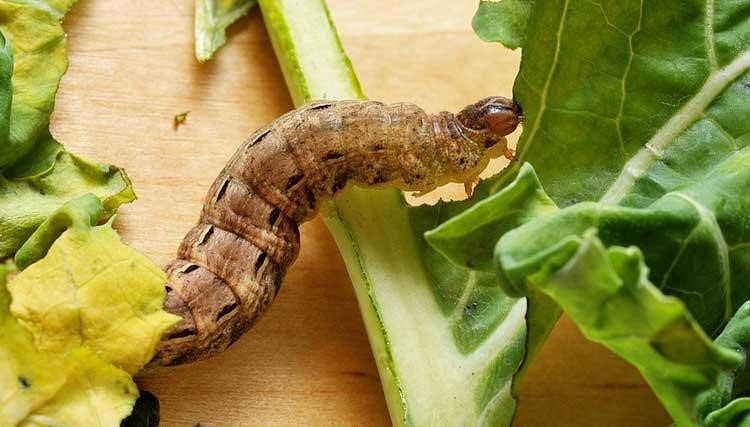
Cutworms are the tiny grub caterpillars that curl up, making a C shape, when you touch them. They feed on the stem of the plant at night. And even feed on seedling until it dies. The name implies what it’s capable of – chew right through the stem.
6. Thrips

Thrips serve as a vector in tomato viruses that affect the growth of the tomato plant. These insects have piercing mouth parts and love feeding on expanding plant tissues. They often prey on tomato seedlings.
7. Tomato Fruit Worm
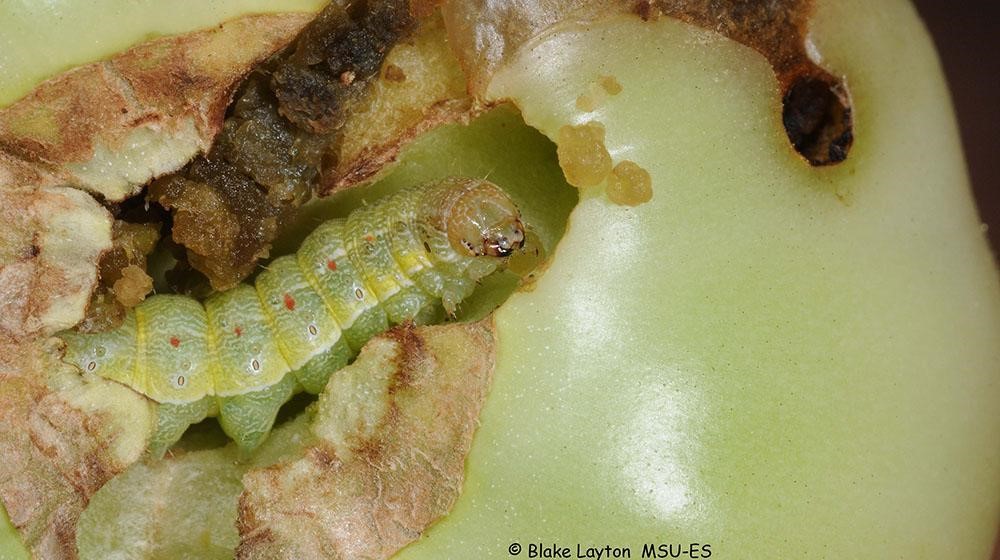
Tomato fruit worms are the suspects for the holes in tomato fruits. They are also called corn earworms or cotton bollworms in some regions.
This larva is responsible for the nicely cut holes on the skin of tomatoes. It feeds on one tomato to the other affecting several fruits in one eating.
8. Colorado Potato Beetle
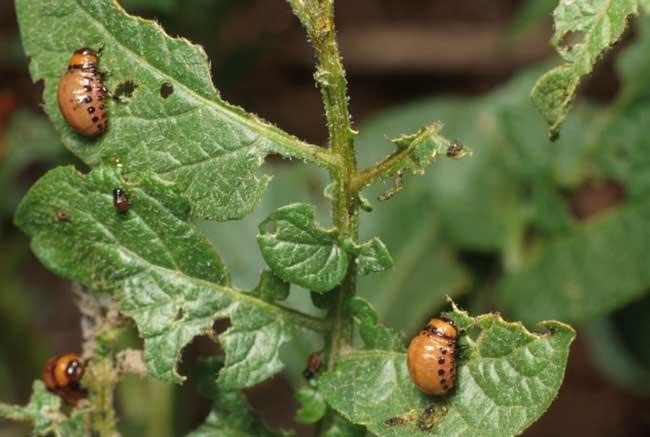
Colorado potato beetles are one of the biggest threats in potato, tomato, and eggplant farming. They can eat all of the leaves of your tomato plant and can even kill it in extreme cases.
These insects can develop a higher level of resistance towards the insecticides used to kill them.
Best Insecticides For Tomatoes By Category – Reviews and Recommendations (2023)
Now that you have an idea of what kind of insect is causing the infestation in your garden, it’s time to identify the best insect spray for your tomatoes.
There are two ways insecticides work in controlling pests:
- Contact insecticides – These are types of insecticides that kill the insects once they come in contact with the insecticide.
- Systemic insecticides – These insecticides work from the ground up to the leaves. The plant absorbs the insecticide from the soil and distributes it to its system.
Now, let’s tackle the different classifications of insecticides:
Best Botanical Insecticides For Tomatoes
Botanical insecticides are natural insecticides that come from plants. Each type of botanical insecticide can kill certain types of insects.
The most common botanical insecticide in the market is Pyrethrin (Persian powder).
Pyrethrin can help control aphids, caterpillars(hornworms), and are effective for high infestation of beetles. It is a contact insecticide derived from chrysanthemum flowers making it the perfect insecticide for organic farmers.
Pyrethrin works by delaying the nerve activity in insects that results in paralysis and death. The best brands of Pyrethrin in the market are:
1. Bonide – Pyrethrin Garden Insect Spray Mix
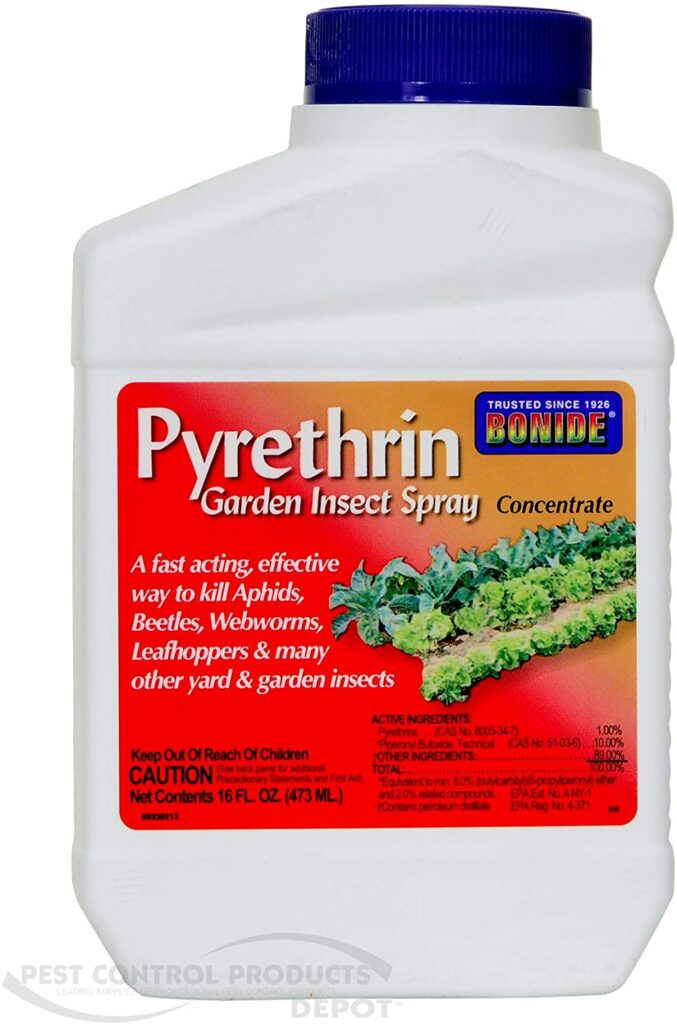
One of the popular brands of pyrethrin in the market and works as a contact insecticide. It’s praised for its effectiveness in controlling beetle and aphid infestations. Since this is a concentrate the 16 oz. can go a long way.
2. MGK Riptide Water-Based ULV
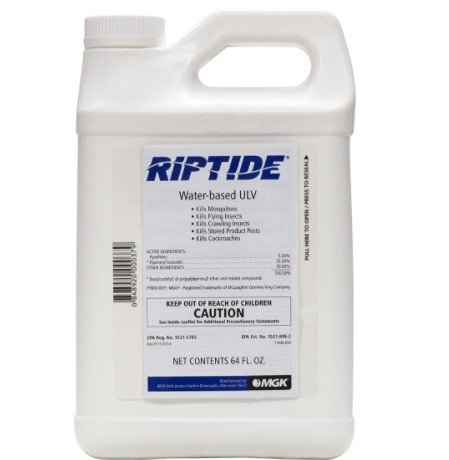
Another type of contact insecticide fused by most organic gardeners. Most gardeners find this product effective with root aphids, whiteflies, and spider mites. You can use it with a ULV fogger or apply it to your misting system.
Editor’s Note:
Rotenone and Sabadilla are natural pesticides used for centuries. However, regardless of their organic nature, they can irritate your eyes and even lungs. The commercial production of these pesticides was phased and no longer advised to be used for use.
Best Biological Insecticides For Tomatoes
Biological insecticides or biopesticides are the toxins produced by living organisms or the living organism itself that has the ability to kill insects. The active ingredient in these insecticides are fungi, bacteria, and nematodes. Some organic gardeners recommend insecticides under this category for mild pest infestations.
The most popular insecticide under this category includes:
1. Bacillus Thuringiensis or BT
A soil bacterium that emits toxic proteins that can kill insects when they eat it. It’s not a systemic nor a contact pesticide.
The Bt bacteria is only activated when the insect ingests them because the bacteria paralyzes the digestive system of the insect and kills them through starvation.
Bt can kill young larvae than adult ones and it’s not toxic to beneficial insects like bees except larvae of butterflies.
It is an effective solution for the caterpillar type of insects like hornworms and fruit worms infestation. It remains active for 24-48 hours and can be used until you harvest your tomatoes.
For best results, use it once a week especially when the larvae are young. Too much Bt can damage the leaves and fruit of your tomatoes so use it in moderate amounts.
If your garden is infested with larvae, here are some BT insecticide brands you can try:
1. Safer Brand Caterpillar Killer II Concentrate
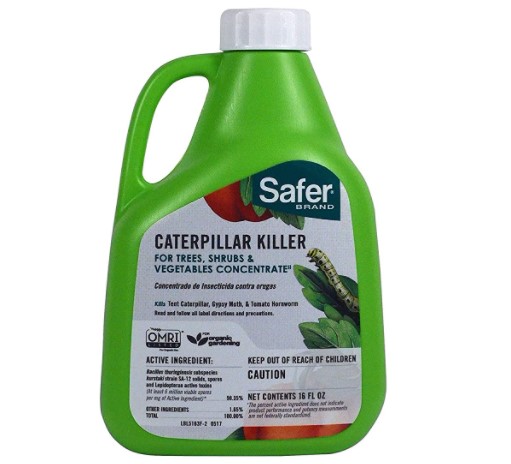
One of the top-of-the-line organic insecticides that are worth the price for most organic gardeners.
Its active ingredient is BT that’s notorious for killing worms in most of its kind like hornworms.
2. Monterey Bacillus Thuringiensis (B.T.) Worm & Caterpillar Killer Spray
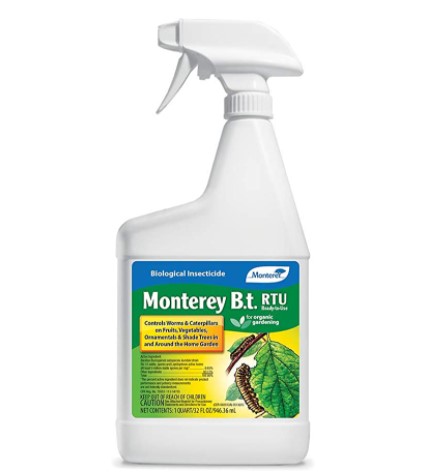
Another green thumb favorite because of its rapid effect on infested vegetable gardens. Since BT is safe for humans, you don’t have to worry about toxicity.
Once a week applications of this product are known to be enough to kill the sneaky crawlies in your garden.
3. Valent USA Dipel Pro DF Biological insecticide BT 54%
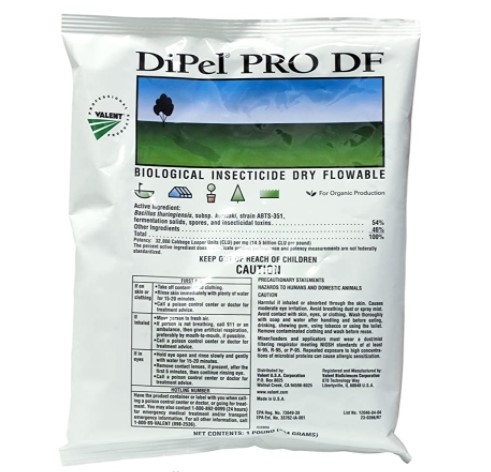
A cheaper version of BT that’s applied as dust. It’s not effective for tomato fruit worms and cutworms but also for cabbage loopers. Directions for use are included in the product that makes new tomato growers love this product.
2. Spinosad
A natural insecticide derived bacterium found in soil. It is commonly used to kill thrips and caterpillar infestation on tomatoes.
Like BT, it only works when the insects ingest it. It has a longer residual period that can last up to 20 days.
You can use spinosad within three days before harvesting your tomatoes.
Here some of the common spinosad insecticide in the market:
1.Monterey Spinosad Concentrate
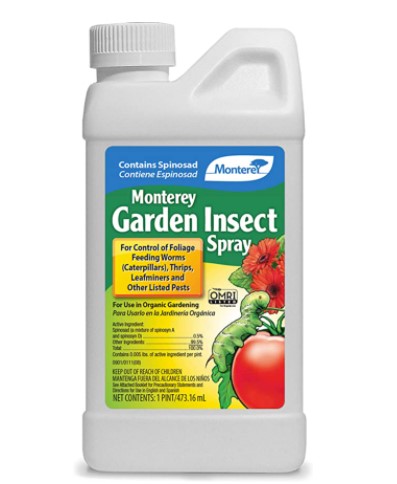
Not only good for controlling thrips in tomatoes but also on fire ants, leaf miners, and cabbage worms. The effect on the insect may take a while but you’ll see dead insects around for the next couple of days.
2.Natural Guard Spinosad Soap
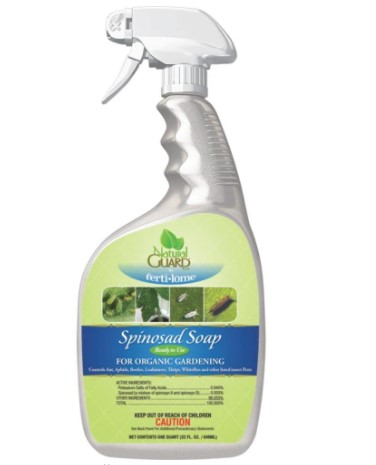
A soap spray version of spinosad that aims to speed up infestation control. Growers consider this product as a good natural alternative for strong insecticides in the market.
3. Abamectin
Abamectin is also another pesticide derived from a soil bacterium. It helps control insects and mites infestations. Studies found that it is also good alternative pest control for nematodes or roundworms in tomatoes.
Popular brands for this insecticide include:
1.Syngenta – 25837 – Avid 0.15EC

Syngenta contains Abamectin as its active ingredient and works best on spider mites infestation. It only takes a few applications of this insecticide to see the results.
2.Abamectin 0.15 EC
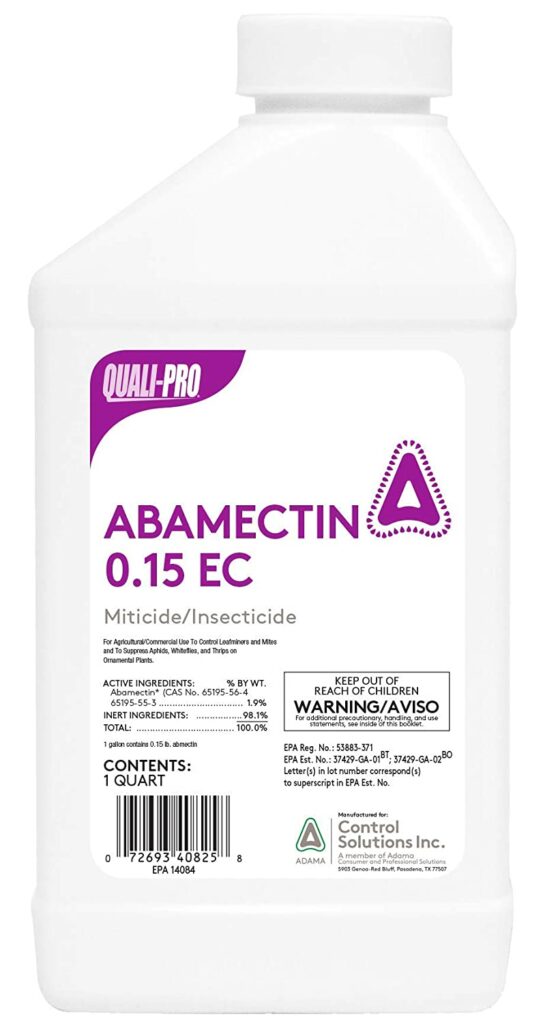
A stronger variation of Abamectin. It is highly concentrated so a bottle can go a long way. Due to its strength, some growers only need one application to solve their infestation problems.
Best Insecticidal Soaps For Tomatoes
Insecticidal soaps are one of the traditional insecticides that are used for centuries. The fatty acids in soap react with the nerve cells of insects and dehydrate them until they die.
If you have kids or pets around the house, insecticidal soaps are a good option for your garden because it has very low toxicity.
Insecticidal soaps are a contact insecticide that works best in controlling aphids and whiteflies.
However, it doesn’t have residual power and only works perfectly when applied directly on pests. They can also harm beneficial insects like ladybugs.
Here are some of the top brands of insecticidal soaps that you can try for your tomatoes:
1. Safer Brand Insecticidal Soap & Pyrethrin Concentrate
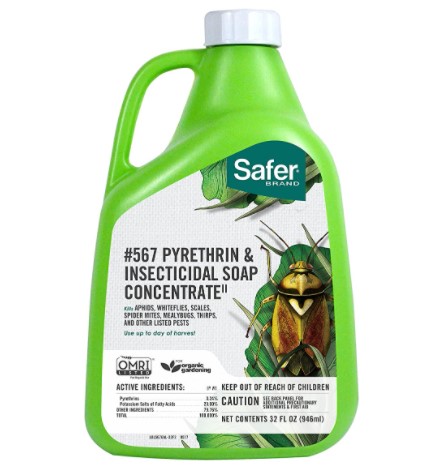
This product works best on whiteflies and springtails in tomatoes, and pine fly caterpillars. However, we recommend that you use it with caution since some gardeners found it toxic to bees.
2. Natural Guard Insecticidal Soap
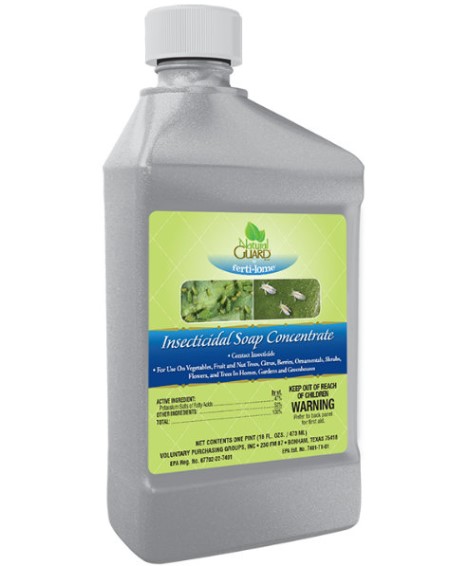
A new brand that is most recommended by tomato growers due to its effectiveness against aphids. It also works best on rolly bugs and spittlebugs found in home gardens.
Best Oil-Based Insecticides For Tomatoes
Oil-based insecticides are the most natural and organic way of controlling pests in tomatoes. Most oil insecticides work best in controlling aphids and whiteflies. It is the organic farmers’ favorite because it is less toxic to animals and the environment.
You can spray oil-based insecticides on your growing tomato plants. However, petroleum-based insecticidal oils should not be used on tomatoes.
There are two common insecticidal oils for tomatoes namely:
1. Neem Oil
Neem oil is extracted from seeds of the neem tree which is the main component of most beauty products. It is a great growth regulator for tomatoes and helps repel pests. It is a less toxic alternative for aphids, leafminers, cabbage worms, and whiteflies.
Here are some of the top brands of neem oil insecticide that you can try for your tomatoes:
1. Greenive Cold Pressed Virgin Neem Oil
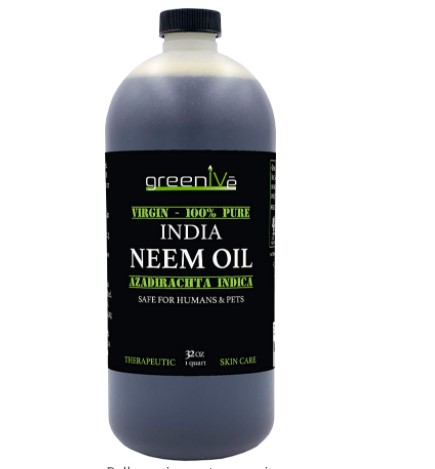
Natural pest control for spider mites and aphids. It has a bit of an odor that may linger in your house if your plants are placed indoors or on the balcony.
2. Safer 5182-6 Brand Neem Oil
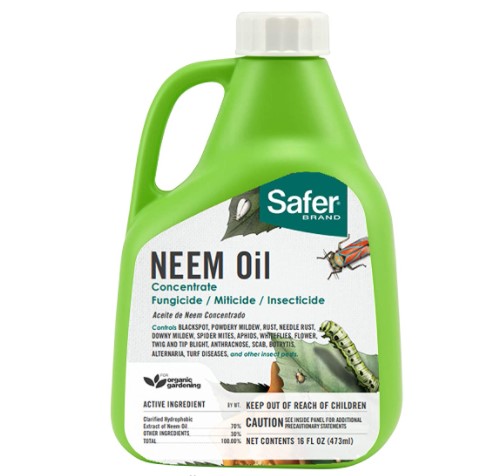
A natural option for Safer Brand fans. It is known to be effective for controlling gnats, aphids, and even for plant fungus in tomatoes. It’s suitable for mild pest infestations.
3. Bonide Ready-to-Use Neem Oil
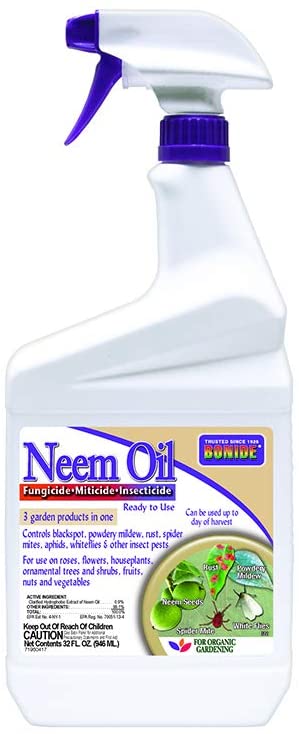
Best for those tomato growers who don’t have plenty of time for gardening and looking for a natural insecticide. It works wonders against fungus, aphids and whiteflies in tomatoes.
2. Horticultural Oil
Horticultural oil targets stink bugs and serves as a less toxic option in controlling spider mites, aphids, and whiteflies. It is a contact insecticide and works by smothering pests. It has no residual power and should be applied directly on pests.
Here’s the gardener’s favorite under the horticultural oil category:
Bonide Concentrate All Seasons Horticultural Spray Oil
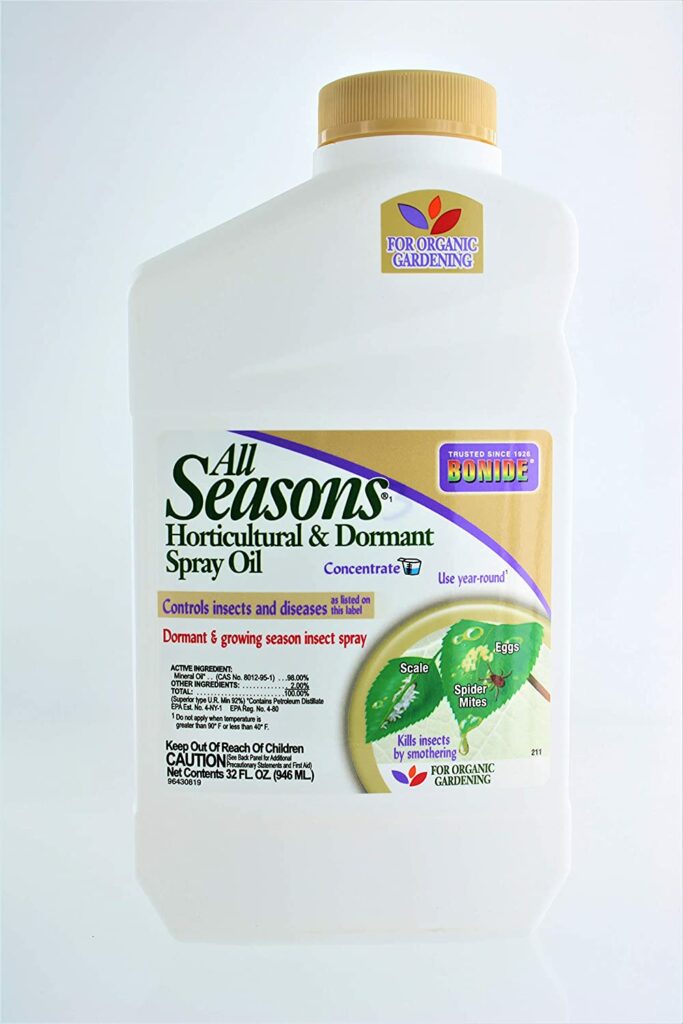
This product is loved by many growers who don’t want to gamble with toxic insecticides but still look for effective infestation solutions. It works well with spider mites and bagworms infestation.
Editor’s Note: Other Natural Insecticides For Worm Infestations
Diatomaceous earth is a chalky type of rock composed of marine fossils grounded into off-white powder. It can kill insects on contact and one of the organic insecticides that most farmers use. It is a multipurpose powder that can be used to control animal fleas and crop infestations.
Our Recommended Product:
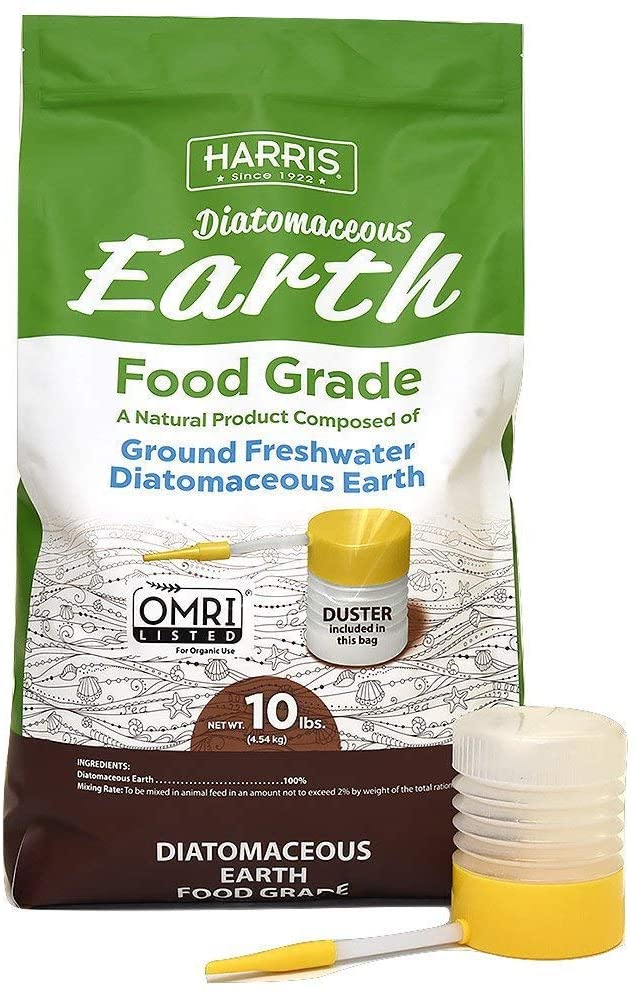
HARRIS Diatomaceous Earth Food Grade, 10lb with Powder Duster is a good brand to start with in using diatomaceous earth. It comes with a free duster!
Best Synthetic Insecticides For Tomatoes
While natural options are available, heavy infestation in tomatoes may need a stronger insecticide. Synthetic Insecticides are contact insecticides that contain chemicals that are highly toxic to insects. It is mostly used in commercial farming and may have adverse effects on the environment.
Here are some of the common types of synthetic insecticides used today:
1.Permethrin is a type of synthetic contact insecticide that is highly toxic to bees and should be applied in the evening. This is also used as an insect repellent and medication for scabies as it kills scabies mites.
2.Carbaryl is a man-made contact insecticide found as an active ingredient in the popular insecticide Sevin Dust. It can kill both pests and beneficial insects. It has a residual effect for 2 to 3 weeks.
Our Recommended Product:
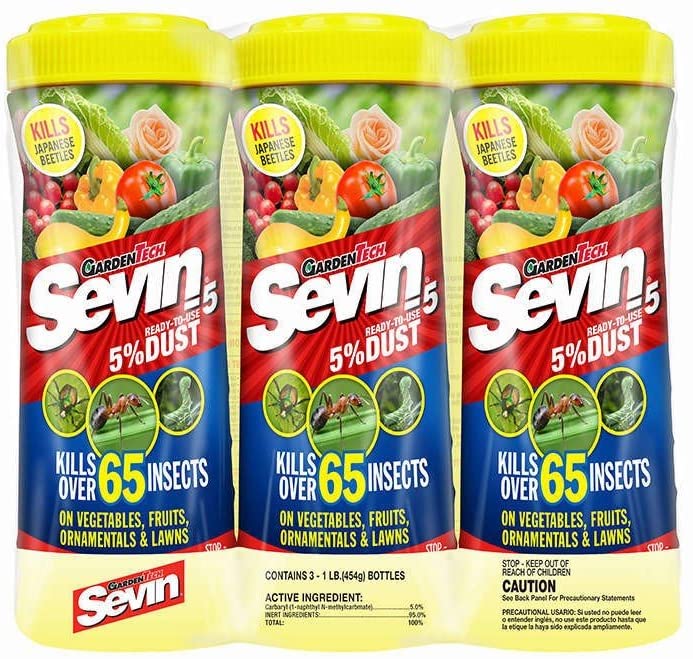
3.Imidacloprid is another man-made insecticide that has the same properties as nicotine that’s found in tobacco. It is used to control pests like sucking and soil insects, termites, and fleas on pets.
4.Indoxacarb is an insecticide developed to control larvae in plants. It’s the active ingredient found in Syngenta commercial insecticides like Arilon.
Our Recommended Product:
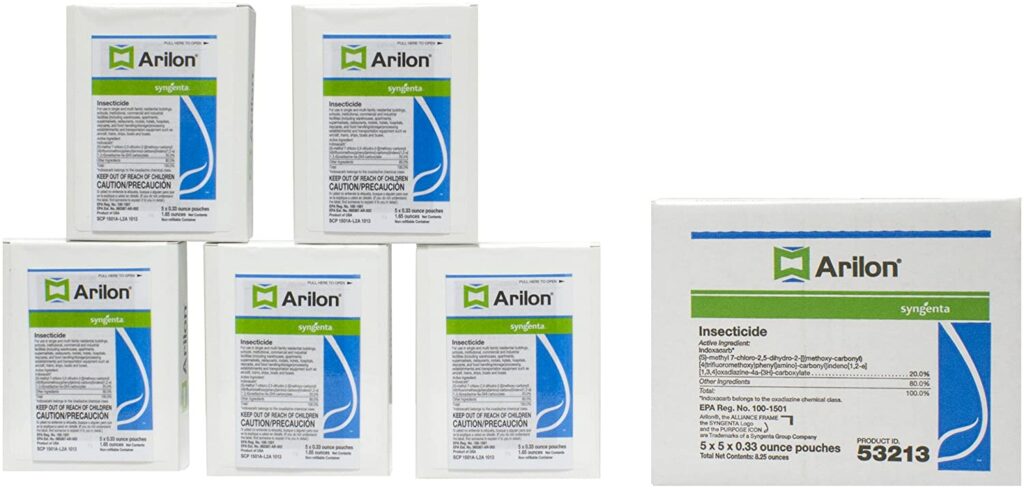
Editor’s Note:
- Chlorpyrifos is a contact insecticide that controls a wide variety of pests and was commercially introduced in the market in 1965. However, it was rumored to have harmful effects on humans and was banned from use in 2000.
Due to the lack of scientific evidence that connects chlorpyrifos to developmental problems in children, EPA decided to lift the ban in 2017. Today, this insecticide is still used by commercial tomato farms. However, studies suggest that there’s a residue of this pesticide even if the tomatoes were processed.
- Other synthetic insecticides in the market: Bifenthrin, Cyholothrin, Malathion & Cyfluthrin.
DIY Insecticides For Tomatoes
If you’re a fan of DIY projects and wish to treat your tomatoes with homemade insecticide, you will not run out of options.
In fact, we listed most of the homemade tomato insecticides for you. You can either try everything until you find what works or stick to one method and figure out how it will work for your tomatoes.
A. Rhubarb leaves
- Boil rhubarb leaves for 5 minutes and drain the water.
- Add a few drops of dish soap to the boiled rhubarb solution, let it cool and spray on the area where you found the whiteflies.
B. Cayenne pepper, onion and garlic
- Blend cayenne pepper, onion, and garlic.
- Add water and place it in a spray bottle and use it as your insect spray.
C. DIY insecticidal soap
- Mix 1-gallon water and 4 to 5 tbsp. of castile soap.
- Add 1 tbsp. of vegetable oil and let it sit for a few minutes before using.
D. Garlic spray
- Chop 20 garlic cloves and put it in a pot with 1 to 2 liters of water
- Boil the garlic for 10 to 20 minutes while stirring it occasionally.
- Let it cool. Then add a few drops of dish soap and vegetable oil.
E. Chili pepper powder spray or dust
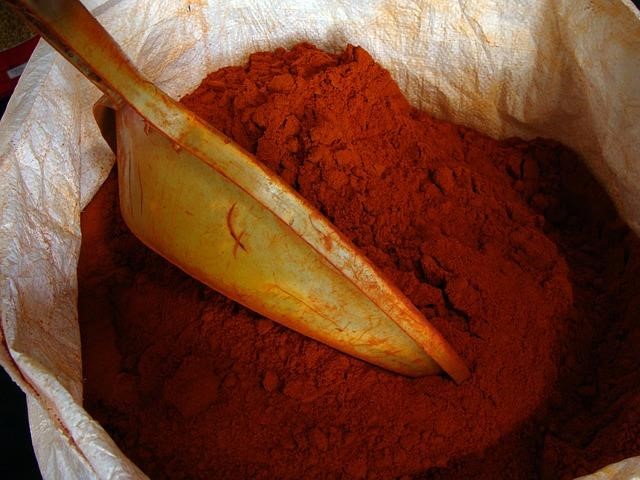
- Mix 1.5 tsp. of chili powder and 2 to 3 drops of dish soap in a liter of water.
- Use it as an insect spray for your tomatoes.
- Chili powder can also serve as insecticidal dust for your tomato plants.
F. Hydrogen peroxide solution
- Mix 8 to 10 oz. of hydrogen peroxide and 16 tbsp. of sugar in a gallon of water.
- Mix well and apply it on the top and underside of tomato leaves.
G. Vinegar solution
- Mix three parts of water and 1 part of vinegar.
- Transfer the solution to a spray bottle and use it accordingly.
H. Baking soda solution
- Mix 1 tbsp. of baking soda and 1 tbsp. of dish soap plus 1 tbsp of vegetable oil in a gallon of water.
- Transfer in a spray bottle and use accordingly.
Tips in Applying Insecticides on Tomatoes
Tomatoes require a balance of warm weather, good soil condition, good water condition and proper application of insecticides. Too much insecticide or untimed application of insecticide can kill your tomatoes.
So, before you put the bugs to rest, check out these helpful tips in applying insecticides in tomatoes:
- Weak tomato plants are magnets of insect pests.
- Remove visible pests by hand before buying an insecticide. Use insecticides if the infestation is out of control or you can’t spot the insects that cause the problem.
- Good or beneficial insects are also your ally in controlling the insect pests but they can also die with insecticides.
- It is advised to use insecticides as needed to keep the beneficial insects alive and maintain a healthy ecosystem in your home garden.
- Do not use permethrin on tomato plants with budding fruits that have a diameter of less than an inch.
- Sprays have better coverage and retain the insecticides on the plants longer than dust.
- Apply insecticides on both on top of the leaf and on its underside.
- Pollinating insects like bees can be affected by the use of pesticides.
- Spray insecticides late in the evening to avoid killing the good or beneficial insects. The same goes for applying insecticidal soaps and oils. Most insects, both beneficial and those considered as pests, are active when the sun is up.
- Avoid applying insecticides when it’s windy to avoid killing nearby beneficial insects like ladybugs.
- Some insecticides can burn your tomato plants if applied in direct sunlight. Follow the manual or direction to avoid such instances.
- Too concentrated solution can damage tomato plants.
- If you’re not sure if you dilute the concentrated insecticide properly, test the solution on some tomato leaves first. Then check for burns or wilting signs within 24 hours.
Cultural Techniques To Keep Your Tomatoes Healthy and Repel Insects Naturally
Aside from insecticides, there are other factors that invite pests to your home garden. Tomatoes in particular need certain care so it can grow healthy.
To make sure your tomato plant is in good condition to repel harmful pests, check the following factors:
1. Does Your Tomato Plant Have Enough Mulch?
Mulch helps protect tomatoes from rotting, weeds and maintains the moisture on the soil. Without enough mulch, your tomatoes can be prone to fungus or other plant diseases that may kill your plant.
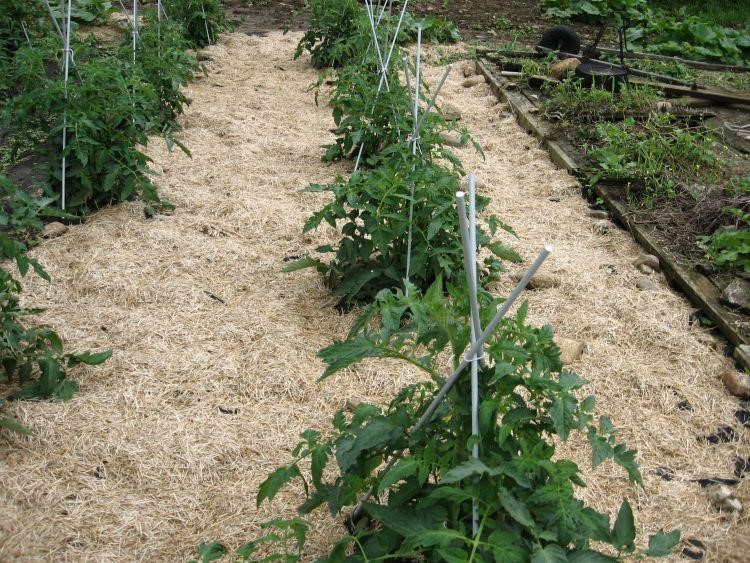
2. Applying Agricultural Lime and Fertilizer
Soil condition is one of the factors in growing healthy tomatoes. Agricultural lime helps balance the pH level and acidity of the soil and fertilizer provides all the nutrients that the tomato needs during its growing season.
3. Don’t Water Established Tomato Plants Too Much
Overwatering plants can cause them to wilt because the roots can drown from too much water. You just need to water your tomato plants with 1 inch of water per week.
4. Plant Spacing
Fruitworms will be the happiest if you plant your tomatoes too close to each other and enjoy hopping and feasting from one tomato fruit to another.
Make sure to plant tomatoes 18 to 24 inches apart so their roots won’t compete with soil nutrients and make room for healthy growth.
What Are The Beneficial Insects in Tomatoes?
We have mentioned a lot in this post about the beneficial insects in your home garden and the risks of killing them when you use insecticides.
Beneficial insects help pollinate the plants and they can even help you fight the pests in your tomato plants.
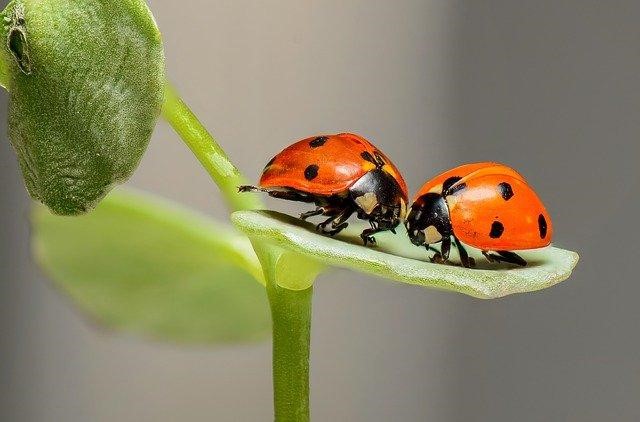
To help you identify what are the beneficial insects that you should protect in your garden, we’ve listed them down below:
- Ladybugs – the larvae and the old ladybugs eat small pests like aphids and whiteflies.
- Lacewings – the Lacewings larvae can eat up to 200 smaller insects in your garden. They are one of your allies so make sure you don’t kill them with insecticides.
- Praying mantis – this dancing insect loves eating insects, mites, and their eggs too. Their cocoon contains 200 more allies so make sure to love those praying mantes because they’re guarding your garden when you’re not around.
- Spiders – The spider webs around your tomato plants is one of the best strategies set up by spiders to eat more pests. Let them feast on the aphids, hold the fort and keep the tomatoes safe while you’re away.
Final Thoughts
We hope that this post helped you find the best insecticide for your tomatoes. The key to successful pest control is to use the right fertilizer for the pests that are ruining your tomato garden.
If you find this post helpful, share this post with your friends and family so you can help them buy the best insecticides for tomatoes too.
What’s the best insecticide that did the trick for your tomatoes? Share your experiences in the comments section below!
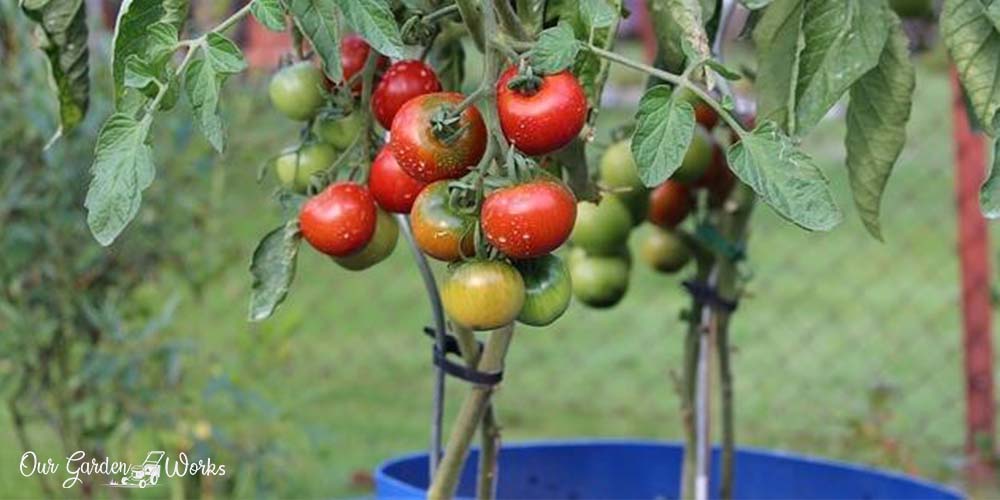
The one I have liked in DIY insecticides for tomatoes is Garlic spray
I learned a lot from this article thanks